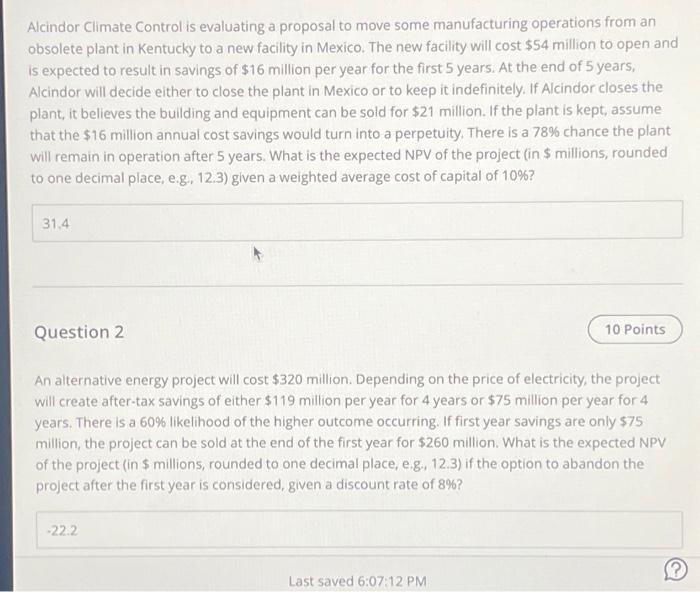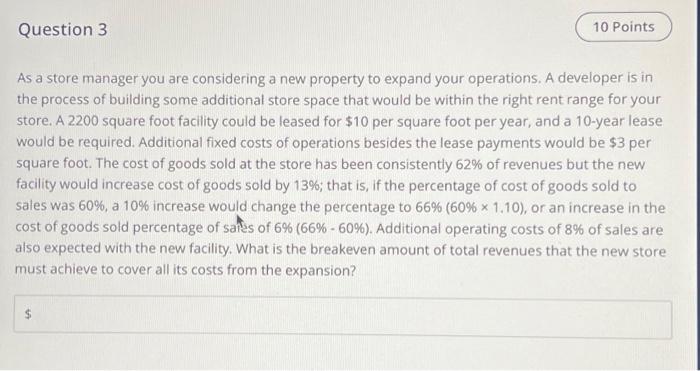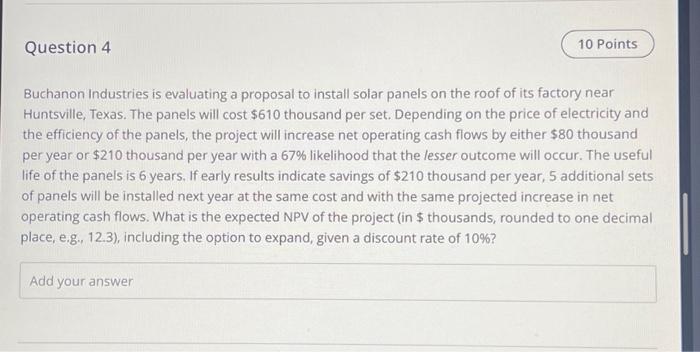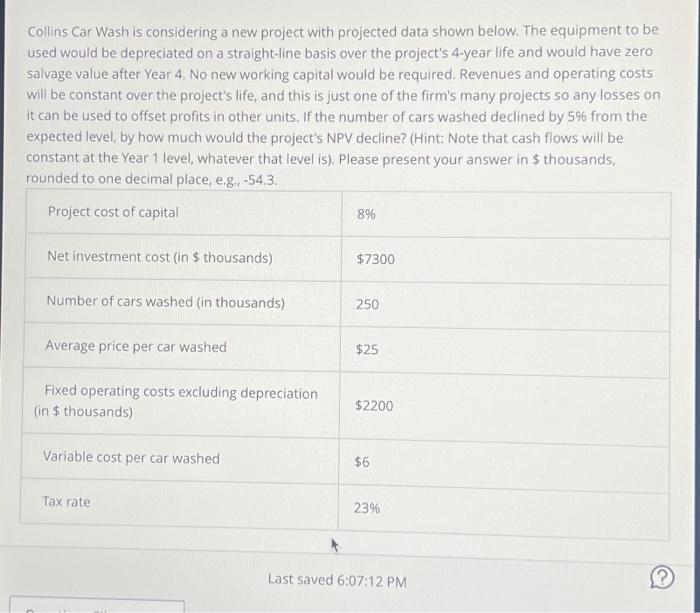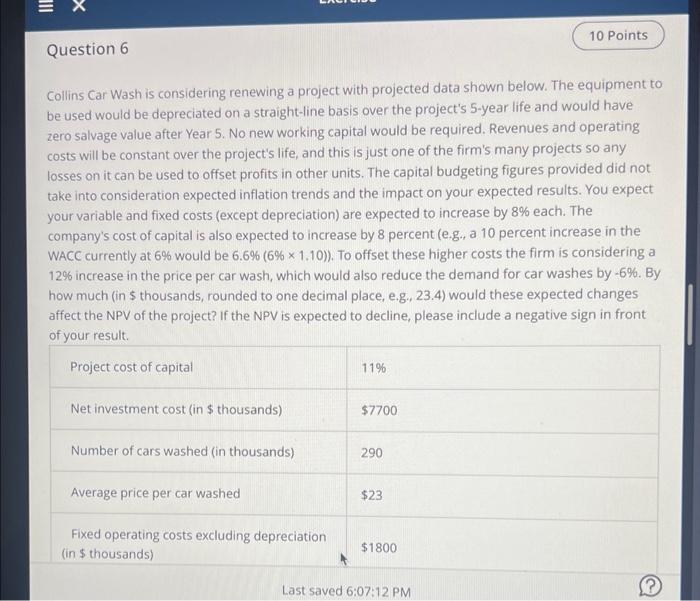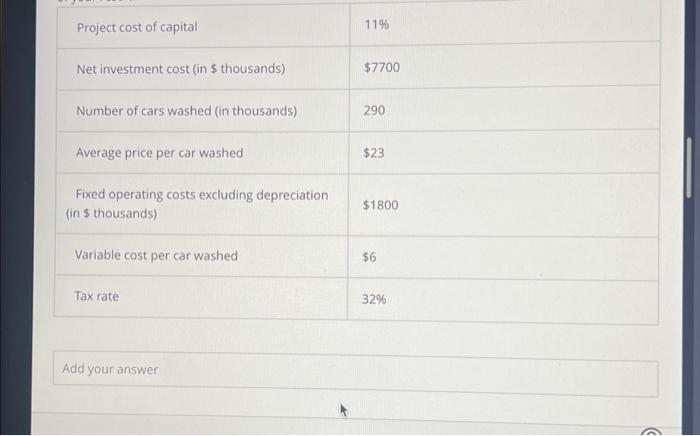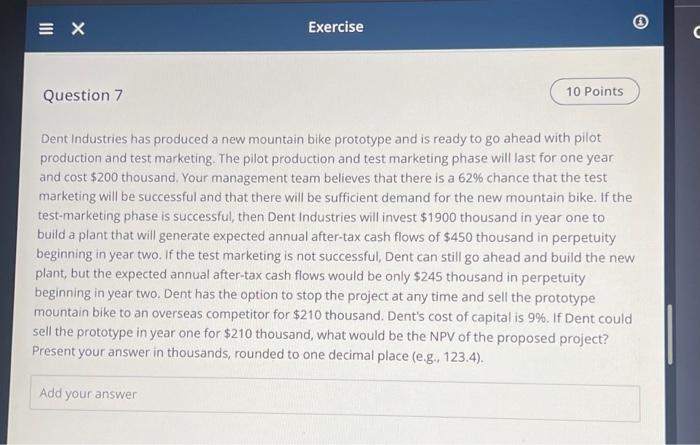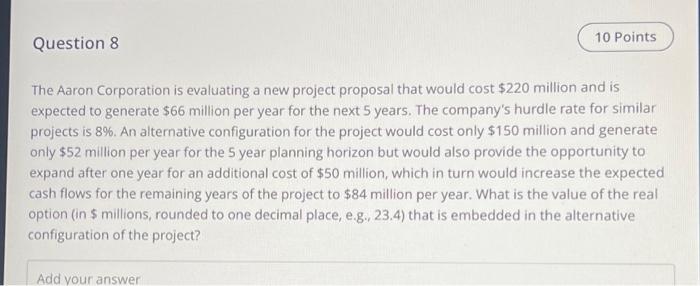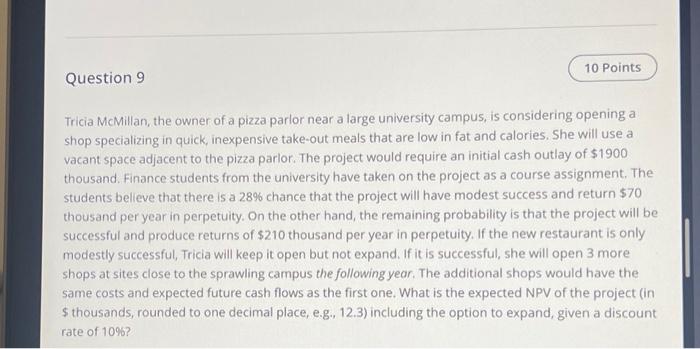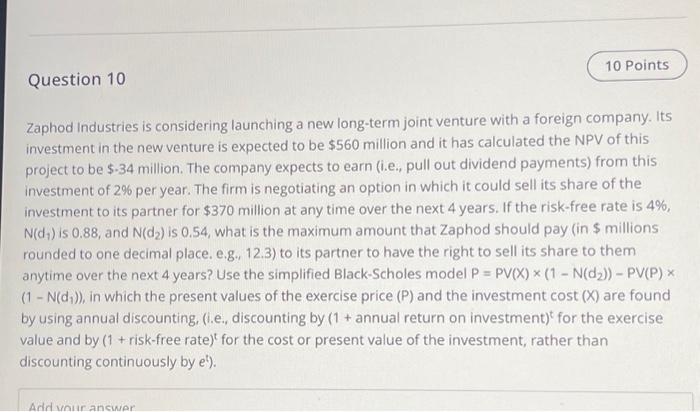Alcindor Climate Control is evaluating a proposal to move some manufacturing operations from an obsolete plant in Kentucky to a new facility in Mexico. The new factlity will cost $54 million to open and is expected to result in savings of $16 million per year for the first 5 years. At the end of 5 years, Alcindor will decide either to close the plant in Mexico or to keep it indefinitely. If Alcindor closes the plant, it believes the building and equipment can be sold for $21 million. If the plant is kept, assume that the $16 million annual cost savings would turn into a perpetuity. There is a 78% chance the plant will remain in operation after 5 years. What is the expected NPV of the project (in \$ millions, rounded to one decimal place, e.g. 12.3) given a weighted average cost of capital of 10% ? Question 2 An alternative energy project will cost $320 million. Depending on the price of electricity, the project will create after-tax savings of either $119 million per year for 4 years or $75 million per year for 4 years. There is a 60% likelihood of the higher outcome occurring. If first year savings are only $75 million, the project can be sold at the end of the first year for $260 million. What is the expected NPV of the project (in \$ millions, rounded to one decimal place, e.g. 12.3) if the option to abandon the project after the first year is considered, given a discount rate of 8% ? As a store manager you are considering a new property to expand your operations. A developer is in the process of building some additional store space that would be within the right rent range for your store. A 2200 square foot facility could be leased for $10 per square foot per year, and a 10-year lease would be required. Additional fixed costs of operations besides the lease payments would be $3 per square foot. The cost of goods sold at the store has been consistently 62% of revenues but the new facility would increase cost of goods sold by 13%; that is, if the percentage of cost of goods sold to sales was 60%, a 10% increase would change the percentage to 66%(60%1.10), or an increase in the cost of goods sold percentage of sats of 6%(66%60%). Additional operating costs of 8% of sales are also expected with the new facility. What is the breakeven amount of total revenues that the new store must achieve to cover all its costs from the expansion? Buchanon Industries is evaluating a proposal to install solar panels on the roof of its factory near Huntsville, Texas. The panels will cost $610 thousand per set. Depending on the price of electricity and the efficiency of the panels, the project will increase net operating cash flows by either $80 thousand per year or $210 thousand per year with a 67% likelihood that the lesser outcome will occur. The useful life of the panels is 6 years. If early results indicate savings of $210 thousand per year, 5 additional sets of panels will be installed next year at the same cost and with the same projected increase in net operating cash flows. What is the expected NPV of the project (in $ thousands, rounded to one decimal place, e.g., 12.3), including the option to expand, given a discount rate of 10% ? Collins Car Wash is considering a new project with projected data shown below. The equipment to be used would be depreciated on a straight-line basis over the project's 4-year life and would have zero salvage value after Year 4. No new working capital would be required. Revenues and operating costs will be constant over the project's life, and this is just one of the firm's many projects so any losses on it can be used to offset profits in other units. If the number of cars washed declined by 5% from the expected level, by how much would the project's NPV decline? (Hint: Note that cash flows will be constant at the Year 1 level, whatever that level is). Please present your answer in \$ thousands, rounded to one decimal place, e.g. =54.3. \begin{tabular}{|l|l|} \hline Project cost of capital & 8% \\ \hline Net investment cost (in \$ thousands) & $7300 \\ \hline Number of cars washed (in thousands) & 250 \\ \hline Average price per car washed & $25 \\ \hline Fixed operating costs excluding depreciation & $2200 \\ \hline (in \$ thousands) & $6 \\ \hline Variable cost per car washed & 23% \\ \hline Tax rate \end{tabular} Last saved 6:07:12 PM Collins Car Wash is considering renewing a project with projected data shown below. The equipment to be used would be depreciated on a straight-line basis over the project's 5-year life and would have zero salvage value after Year 5 . No new working capital would be required. Revenues and operating costs will be constant over the project's life, and this is just one of the firm's many projects so any losses on it can be used to offset profits in other units. The capital budgeting figures provided did not take into consideration expected inflation trends and the impact on your expected results. You expect your variable and fixed costs (except depreciation) are expected to increase by 8% each. The company's cost of capital is also expected to increase by 8 percent (e.g., a 10 percent increase in the WACC currently at 6% would be 6.6%(6%1.10)). To offset these higher costs the firm is considering a 12% increase in the price per car wash, which would also reduce the demand for car washes by 6%. By how much (in \$ thousands, rounded to one decimal place, e.g., 23.4) would these expected changes affect the NPV of the project? If the NPV is expected to decline, please include a negative sign in front of vour result. \begin{tabular}{|l|c|} \hline Project cost of capital & 11% \\ \hline Net investment cost (in $ thousands) & $7700 \\ \hline Number of cars washed (in thousands) & 290 \\ \hline \begin{tabular}{l} Average price per car washed \\ \hline Fixed operating costs excluding depreciation \end{tabular} & $23 \\ \hline (in $ thousands) & $600 \\ \hline Variable cost per car washed & 32% \\ \hline \end{tabular} Add your answer Dent Industries has produced a new mountain bike prototype and is ready to go ahead with pilot production and test marketing. The pilot production and test marketing phase will last for one year and cost $200 thousand. Your management team believes that there is a 62% chance that the test marketing will be successful and that there will be sufficient demand for the new mountain bike. If the test-marketing phase is successful, then Dent Industries will invest $1900 thousand in year one to build a plant that will generate expected annual after-tax cash flows of $450 thousand in perpetuity beginning in year two. If the test marketing is not successful, Dent can still go ahead and build the new plant, but the expected annual after-tax cash flows would be only $245 thousand in perpetuity beginning in year two. Dent has the option to stop the project at any time and sell the prototype mountain bike to an overseas competitor for $210 thousand. Dent's cost of capital is 9%. If Dent could sell the prototype in year one for $210 thousand, what would be the NPV of the proposed project? Present your answer in thousands, rounded to one decimal place (e.g., 123.4). The Aaron Corporation is evaluating a new project proposal that would cost $220 million and is expected to generate $66 million per year for the next 5 years. The company's hurdle rate for similar projects is 8%. An alternative configuration for the project would cost only $150 million and generate only $52 million per year for the 5 year planning horizon but would also provide the opportunity to expand after one year for an additional cost of $50 million, which in turn would increase the expected cash flows for the remaining years of the project to $84 million per year. What is the value of the real option (in \$ millions, rounded to one decimal place, e.g., 23.4) that is embedded in the alternative configuration of the project? Tricia McMillan, the owner of a pizza parlor near a large university campus, is considering opening a shop speciatizing in quick, inexpensive take-out meals that are low in fat and calories. She will use a vacant space adjacent to the pizza parlor. The project would require an initial cash outlay of $1900 thousand. Finance students from the university have taken on the project as a course assignment. The students believe that there is a 28% chance that the project will have modest success and return $70 thousand per year in perpetuity. On the other hand, the remaining probability is that the project will be successful and produce returns of $210 thousand per year in perpetuity. If the new restaurant is only modestly successful, Tricia will keep it open but not expand. If it is successful, she will open 3 more shops at sites close to the sprawling campus the following year. The additional shops would have the same costs and expected future cash flows as the first one. What is the expected NPV of the project (in $ thousands, rounded to one decimal place, e.g., 12.3) including the option to expand, given a discount rate of 10% ? Zaphod Industries is considering launching a new long-term joint venture with a foreign company. Its investment in the new venture is expected to be $560 million and it has calculated the NPV of this project to be $.34 million. The company expects to earn (i.e., pull out dividend payments) from this investment of 2% per year. The firm is negotiating an option in which it could sell its share of the investment to its partner for $370 million at any time over the next 4 years. If the risk-free rate is 4%, N(d1) is 0.88 , and N(d2) is 0.54 , what is the maximum amount that Zaphod should pay (in $ millions rounded to one decimal place. e.g. 12.3) to its partner to have the right to sell its share to them anytime over the next 4 years? Use the simplified Black-Scholes model P=PV(X)(1N(d2))PV(P) (1N(d1)), in which the present values of the exercise price (P) and the investment cost (X) are found by using annual discounting, (i.e., discounting by (1+annualreturnoninvestment)t for the exercise value and by (1+risk-freerate)t for the cost or present value of the investment, rather than discounting continuously by et ). Alcindor Climate Control is evaluating a proposal to move some manufacturing operations from an obsolete plant in Kentucky to a new facility in Mexico. The new factlity will cost $54 million to open and is expected to result in savings of $16 million per year for the first 5 years. At the end of 5 years, Alcindor will decide either to close the plant in Mexico or to keep it indefinitely. If Alcindor closes the plant, it believes the building and equipment can be sold for $21 million. If the plant is kept, assume that the $16 million annual cost savings would turn into a perpetuity. There is a 78% chance the plant will remain in operation after 5 years. What is the expected NPV of the project (in \$ millions, rounded to one decimal place, e.g. 12.3) given a weighted average cost of capital of 10% ? Question 2 An alternative energy project will cost $320 million. Depending on the price of electricity, the project will create after-tax savings of either $119 million per year for 4 years or $75 million per year for 4 years. There is a 60% likelihood of the higher outcome occurring. If first year savings are only $75 million, the project can be sold at the end of the first year for $260 million. What is the expected NPV of the project (in \$ millions, rounded to one decimal place, e.g. 12.3) if the option to abandon the project after the first year is considered, given a discount rate of 8% ? As a store manager you are considering a new property to expand your operations. A developer is in the process of building some additional store space that would be within the right rent range for your store. A 2200 square foot facility could be leased for $10 per square foot per year, and a 10-year lease would be required. Additional fixed costs of operations besides the lease payments would be $3 per square foot. The cost of goods sold at the store has been consistently 62% of revenues but the new facility would increase cost of goods sold by 13%; that is, if the percentage of cost of goods sold to sales was 60%, a 10% increase would change the percentage to 66%(60%1.10), or an increase in the cost of goods sold percentage of sats of 6%(66%60%). Additional operating costs of 8% of sales are also expected with the new facility. What is the breakeven amount of total revenues that the new store must achieve to cover all its costs from the expansion? Buchanon Industries is evaluating a proposal to install solar panels on the roof of its factory near Huntsville, Texas. The panels will cost $610 thousand per set. Depending on the price of electricity and the efficiency of the panels, the project will increase net operating cash flows by either $80 thousand per year or $210 thousand per year with a 67% likelihood that the lesser outcome will occur. The useful life of the panels is 6 years. If early results indicate savings of $210 thousand per year, 5 additional sets of panels will be installed next year at the same cost and with the same projected increase in net operating cash flows. What is the expected NPV of the project (in $ thousands, rounded to one decimal place, e.g., 12.3), including the option to expand, given a discount rate of 10% ? Collins Car Wash is considering a new project with projected data shown below. The equipment to be used would be depreciated on a straight-line basis over the project's 4-year life and would have zero salvage value after Year 4. No new working capital would be required. Revenues and operating costs will be constant over the project's life, and this is just one of the firm's many projects so any losses on it can be used to offset profits in other units. If the number of cars washed declined by 5% from the expected level, by how much would the project's NPV decline? (Hint: Note that cash flows will be constant at the Year 1 level, whatever that level is). Please present your answer in \$ thousands, rounded to one decimal place, e.g. =54.3. \begin{tabular}{|l|l|} \hline Project cost of capital & 8% \\ \hline Net investment cost (in \$ thousands) & $7300 \\ \hline Number of cars washed (in thousands) & 250 \\ \hline Average price per car washed & $25 \\ \hline Fixed operating costs excluding depreciation & $2200 \\ \hline (in \$ thousands) & $6 \\ \hline Variable cost per car washed & 23% \\ \hline Tax rate \end{tabular} Last saved 6:07:12 PM Collins Car Wash is considering renewing a project with projected data shown below. The equipment to be used would be depreciated on a straight-line basis over the project's 5-year life and would have zero salvage value after Year 5 . No new working capital would be required. Revenues and operating costs will be constant over the project's life, and this is just one of the firm's many projects so any losses on it can be used to offset profits in other units. The capital budgeting figures provided did not take into consideration expected inflation trends and the impact on your expected results. You expect your variable and fixed costs (except depreciation) are expected to increase by 8% each. The company's cost of capital is also expected to increase by 8 percent (e.g., a 10 percent increase in the WACC currently at 6% would be 6.6%(6%1.10)). To offset these higher costs the firm is considering a 12% increase in the price per car wash, which would also reduce the demand for car washes by 6%. By how much (in \$ thousands, rounded to one decimal place, e.g., 23.4) would these expected changes affect the NPV of the project? If the NPV is expected to decline, please include a negative sign in front of vour result. \begin{tabular}{|l|c|} \hline Project cost of capital & 11% \\ \hline Net investment cost (in $ thousands) & $7700 \\ \hline Number of cars washed (in thousands) & 290 \\ \hline \begin{tabular}{l} Average price per car washed \\ \hline Fixed operating costs excluding depreciation \end{tabular} & $23 \\ \hline (in $ thousands) & $600 \\ \hline Variable cost per car washed & 32% \\ \hline \end{tabular} Add your answer Dent Industries has produced a new mountain bike prototype and is ready to go ahead with pilot production and test marketing. The pilot production and test marketing phase will last for one year and cost $200 thousand. Your management team believes that there is a 62% chance that the test marketing will be successful and that there will be sufficient demand for the new mountain bike. If the test-marketing phase is successful, then Dent Industries will invest $1900 thousand in year one to build a plant that will generate expected annual after-tax cash flows of $450 thousand in perpetuity beginning in year two. If the test marketing is not successful, Dent can still go ahead and build the new plant, but the expected annual after-tax cash flows would be only $245 thousand in perpetuity beginning in year two. Dent has the option to stop the project at any time and sell the prototype mountain bike to an overseas competitor for $210 thousand. Dent's cost of capital is 9%. If Dent could sell the prototype in year one for $210 thousand, what would be the NPV of the proposed project? Present your answer in thousands, rounded to one decimal place (e.g., 123.4). The Aaron Corporation is evaluating a new project proposal that would cost $220 million and is expected to generate $66 million per year for the next 5 years. The company's hurdle rate for similar projects is 8%. An alternative configuration for the project would cost only $150 million and generate only $52 million per year for the 5 year planning horizon but would also provide the opportunity to expand after one year for an additional cost of $50 million, which in turn would increase the expected cash flows for the remaining years of the project to $84 million per year. What is the value of the real option (in \$ millions, rounded to one decimal place, e.g., 23.4) that is embedded in the alternative configuration of the project? Tricia McMillan, the owner of a pizza parlor near a large university campus, is considering opening a shop speciatizing in quick, inexpensive take-out meals that are low in fat and calories. She will use a vacant space adjacent to the pizza parlor. The project would require an initial cash outlay of $1900 thousand. Finance students from the university have taken on the project as a course assignment. The students believe that there is a 28% chance that the project will have modest success and return $70 thousand per year in perpetuity. On the other hand, the remaining probability is that the project will be successful and produce returns of $210 thousand per year in perpetuity. If the new restaurant is only modestly successful, Tricia will keep it open but not expand. If it is successful, she will open 3 more shops at sites close to the sprawling campus the following year. The additional shops would have the same costs and expected future cash flows as the first one. What is the expected NPV of the project (in $ thousands, rounded to one decimal place, e.g., 12.3) including the option to expand, given a discount rate of 10% ? Zaphod Industries is considering launching a new long-term joint venture with a foreign company. Its investment in the new venture is expected to be $560 million and it has calculated the NPV of this project to be $.34 million. The company expects to earn (i.e., pull out dividend payments) from this investment of 2% per year. The firm is negotiating an option in which it could sell its share of the investment to its partner for $370 million at any time over the next 4 years. If the risk-free rate is 4%, N(d1) is 0.88 , and N(d2) is 0.54 , what is the maximum amount that Zaphod should pay (in $ millions rounded to one decimal place. e.g. 12.3) to its partner to have the right to sell its share to them anytime over the next 4 years? Use the simplified Black-Scholes model P=PV(X)(1N(d2))PV(P) (1N(d1)), in which the present values of the exercise price (P) and the investment cost (X) are found by using annual discounting, (i.e., discounting by (1+annualreturnoninvestment)t for the exercise value and by (1+risk-freerate)t for the cost or present value of the investment, rather than discounting continuously by et )
